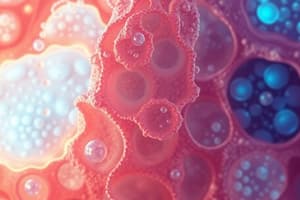Podcast
Questions and Answers
Which type of tissue enables movement and produces force?
Which type of tissue enables movement and produces force?
- Epithelial tissue
- Muscle tissue (correct)
- Connective tissue
- Nervous tissue
What is the main function of connective tissue?
What is the main function of connective tissue?
- Enables movement and produces force
- Provides support, protection, and connection (correct)
- Transmits electrical and chemical signals throughout the body
- Covers and protects the body
Which type of epithelial tissue appears multilayered but has a single layer of cells?
Which type of epithelial tissue appears multilayered but has a single layer of cells?
- Simple epithelial tissue
- Pseudostratified epithelial tissue (correct)
- Connective tissue
- Stratified epithelial tissue
Which type of connective tissue is the most abundant?
Which type of connective tissue is the most abundant?
What is the classification of epithelial tissue based on the number of layers of cells?
What is the classification of epithelial tissue based on the number of layers of cells?
What type of muscle tissue is responsible for involuntary movements?
What type of muscle tissue is responsible for involuntary movements?
What is the function of adipose tissue?
What is the function of adipose tissue?
What do glial cells do in the nervous system?
What do glial cells do in the nervous system?
What does dense connective tissue provide?
What does dense connective tissue provide?
Where is skeletal muscle tissue attached?
Where is skeletal muscle tissue attached?
Flashcards are hidden until you start studying
Study Notes
Tissue: The Building Blocks of Our Body
Tissue, the building blocks of our body, are organized groups of cells performing similar functions. They are specialized structures that provide various functions, such as protection, support, and elimination of waste. There are four main types of tissue, each with distinct characteristics and functions:
- Epithelial tissue: Covers and protects the body, and lines the internal and external surfaces of organs.
- Connective tissue: Provides support, protection, and connects various parts of the body.
- Muscle tissue: Enables movement and produces force.
- Nervous tissue: Transmits electrical and chemical signals throughout the body.
Epithelial Tissue
Epithelial tissue, the most abundant tissue type, covers and protects the body. It is classified into three main types based on the number of layers: simple, stratified, and pseudostratified. Simple epithelial tissue is a single layer of cells that lines the internal and external surfaces of organs. Stratified epithelial tissue consists of multiple layers of cells, providing protection from the constant friction and wear that occurs in areas such as the skin. Pseudostratified epithelial tissue has a single layer of cells that appear multilayered due to the presence of a lining in the lumen.
Connective Tissue
Connective tissue, the most diverse tissue type, provides support, protection, and connects various parts of the body. It is classified into three main types: loose, dense, and specialized. Loose connective tissue, also known as areolar tissue, is the most abundant type of connective tissue and is found between organs, attaching them to the body wall, and providing support for other tissues. Dense connective tissue, which includes both dense regular and dense irregular, provides extra support and protection. Specialized connective tissue includes adipose tissue, which stores energy, and cartilage, which forms the flexible joints and the skeleton of the ear.
Muscle Tissue
Muscle tissue enables movement and produces force. There are three types of muscle tissue: skeletal, smooth, and cardiac. Skeletal muscle tissue, which is attached to bones, is responsible for voluntary movements. Smooth muscle tissue, which is found in the walls of internal organs, is controlled by the autonomic nervous system and is responsible for involuntary movements. Cardiac muscle tissue, found in the walls of the heart, contracts to pump blood throughout the body.
Nervous Tissue
Nervous tissue transmits electrical and chemical signals throughout the body. It consists of two main types: neurons and glial cells. Neurons, the main components of nervous tissue, transmit signals in the form of electrical impulses. Glial cells, the supporting cells of the nervous system, provide structural support, protect neurons, and maintain the health of the nervous system.
In conclusion, tissue is the basic structural and functional unit of all living organisms, providing the foundation for the development of complex and specialized organs in multicellular organisms. Understanding the different types of tissue and their functions is essential for understanding the structure and function of the human body.
Studying That Suits You
Use AI to generate personalized quizzes and flashcards to suit your learning preferences.




